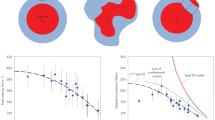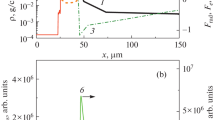Abstract
The paper presents the results of theoretical and experimental studies of the radiative properties of plasmas produced by heating and compression of various materials to high energy densities. The specific features of the theoretical plasma model known as the ion model, which is used to calculate the radiative characteristics of plasmas of complex chemical composition, are discussed. The theoretical approach based on this model is applied to the plasma produced during the explosion of the X-pinch wires. The theoretical estimate of the radiation efficiency is compared with the experimental data on the total energy yield from an X-pinch made of two different wires (NiCr and Alloy 188). The radiative characteristics of (C12 H16 O8) and (C8 H12 O6) plasmas are calculated for the temperature diagnostics of plasmas produced from porous targets employed in inertial confinement fusion experiments with the use of laser radiation and heavy-ion beams.
Similar content being viewed by others
References
D. Batani, R. Dtzulian, R. Redaelli, et al., Laser Part. Beams 25, 127 (2007).
P. Adamek, O. Renner, L. Drska, et al., Laser Part. Beams 24, 511 (2006).
N. Yu. Orlov, Contrib. Plasma Phys. 39, 177 (1999).
O. B. Denisov, N. Yu. Orlov, S. Yu. Gus’kov, et al., Fiz. Plazmy 31, 742 (2005) [Plasma Phys. Rep. 31, 684 (2005)].
N. Yu. Orlov, S. Yu. Guskov, S. A. Pikuz, et al., Laser Part. Beams 25, 1 (2007).
T. J. Orzechowski, M. D. Rosen, M. D. Korblum, et al., Phys. Rev. Lett. 77, 3545 (1996).
N. Yu. Orlov, Laser Part. Beams 15, 627 (1997).
N. Yu. Orlov and V. E. Fortov, Fiz. Plazmy 27, 45 (2001) [Plasma Phys. Rep. 27, 44 (2001)].
N. Yu. Orlov, Zh. Vychisl. Mat. Mat. Fiz. 27, 1058 (1987).
R. Feynman, N. Metropolis, and E. Teller, Phys. Rev. 75, 73 (1949).
B. F. Rozsnyai, Phys. Rev. A 5, 1137 (1972).
A. F. Nikiforov and V. B. Uvarov, Chisl. Metody Mekh. Sploshn. Sred 4(4), 114 (1973).
B. F. Rozsnyai, J. Quant. Spectrosc. Radiat. Transfer 27, 211 (1982).
Ya. B. Zel’dovich and Yu. P. Raizer, Elements of Gas Dynamics and the Classical Theory of Shock Waves (Nauka, Moscow, 1966; Academic, New York, 1968).
D. H. H. Hoffmann and A. Blazevic, Laser Part. Beams 23, 47 (2005).
A. M. Khalenkov, N. G. Borisenko, V. N. Kondrashov, et al., Laser Part. Beams 24, 283 (2006).
O. N. Rosmej, N. Zhidkov, V. Vatulin, et al., GSI Scientific Report 2009 (GSI Helmholtz Centre for Heavy Ion Research, Darmstadt, 2010), p. 387.
O. N. Rosmej, N. Orlov, D. Schafer, et al., GSI Scientific Report 2009 (GSI Helmholtz Centre for Heavy Ion Research, Darmstadt, 2010), p. 391.
Author information
Authors and Affiliations
Additional information
Original Russian Text © O.B. Denisov, N.Yu. Orlov, 2011, published in Fizika Plazmy, 2011, Vol. 37, No. 9, pp. 841–847.
Rights and permissions
About this article
Cite this article
Denisov, O.B., Orlov, N.Y. Theoretical and experimental studies of the radiative properties of matter at high energy densities and their application to the problems of inertial confinement fusion. Plasma Phys. Rep. 37, 785–791 (2011). https://doi.org/10.1134/S1063780X11080010
Received:
Accepted:
Published:
Issue Date:
DOI: https://doi.org/10.1134/S1063780X11080010




